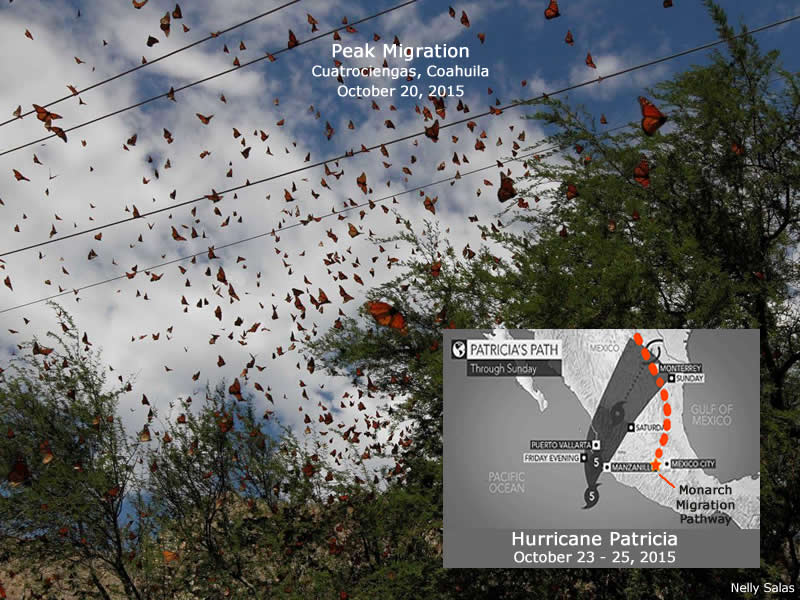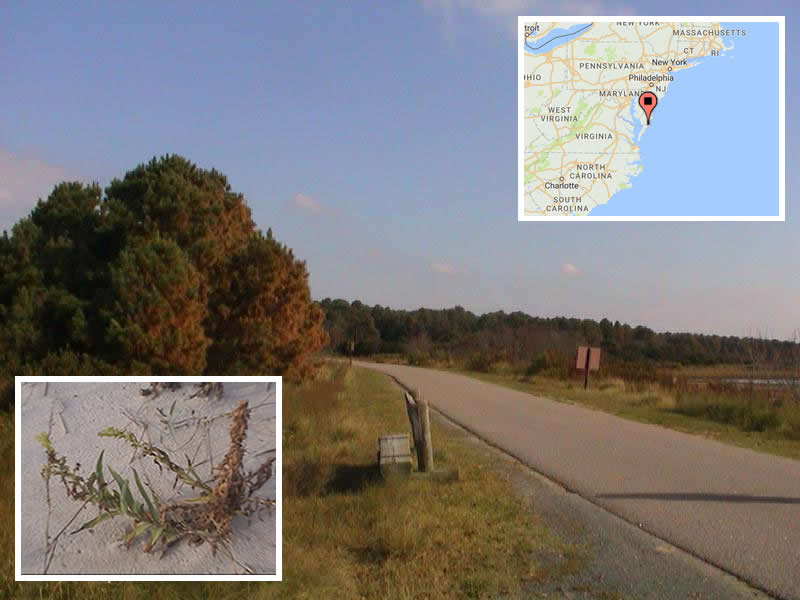How Do Hurricanes Affect Monarchs?
Hurricane Stories
1999-2017
Fall migration takes place during hurricane season. Monarchs depend on the wind to migrate to Mexico, but the wind can also be perilous. Over the years — from Hurricane Floyd in 1999 to Hurricane Harvey in 2017 — people have contributed examples of how extreme storms can affect monarchs during their fall migration.
Sensing an Approaching Storm
On September 10th, 2010 as Hurricane Earl approached the coast of Maine, caterpillars responded before any visual sign of a storm. "The larvae had been feeding on milkweed but — before the hurricane arrived — they vacated the leaves and presumably buried themselves in the leaf litter. After the storm had passed, they reappeared on the plants and resumed feeding," noted monarch expert Dr. Bill Calvert. Scientists think many animal species can sense falling air pressure and then change their behavior accordingly.
Surviving Wind and Rain
In September, 2017, right after Hurricane Harvey, people reported from the Texas Gulf Coast. "Day #2 and there are monarchs all over the place," wrote Jennifer Wyer from Houston. Another observer, Harlen Aschen, has weathered many hurricanes. "We've watched monarchs out the window clinging to the stems of plants when the winds were topping 50 mph. We also saw monarchs flying the day after Hurricane Claudette when we had had 105 mph winds. They know what to do - hunker-down."
Blown Off Course
A monarch was tagged in Ohio on August 26, 2005. A few days later, the remnants of Hurricane Katrina moved through.
On September 3rd, the monarch was recovered in Ontario. Presumably the winds blew the butterfly in the wrong direction. Monarch expert Don Davis wondered, “Was
this Mexico-bound monarch blown by Hurricane Katrina into Ontario, about 165 miles northeast from where
it was tagged?”
Blown to England?
In late September of 1999, Hurricane Floyd swept across eastern North America during peak fall migration. On September 22nd, a nighthawk and a monarch were found together on the coast of England. The nighthawk is a migratory bird that only lives in the Americas. Nobody can be sure, but this unusual sighting suggests that both the bird and the butterfly were carried across the Atlantic to England by the winds.
Blown to England?
Another time that a monarch and a North American bird were discovered in England was after Hurricane Issac in September 2012. "We have seen a few monarchs here over the years — all after storms have swept across the Atlantic. I guess that the butterfly and birds were displaced from their normal migration routes by Hurricane Isaac," said Martin Cade of Portland Bird Observatory. Despite the strong winds and 3,500-mile journey, the butterfly was in remarkably good condition. Only the tips of his wings were broken.
A Narrow Escape
In late October, 2015 while millions of monarchs were funneling across northern Mexico, Hurricane Patricia was headed directly for the migration pathway. Fortunately, the storm system dissipated as it moved across Mexico's rugged landscape. This was a narrow escape for the monarchs. During peak migration, one storm could impact the population on a grand scale.
Overpowered by Wind
After three days of gale-force winds on Lake Michigan in October 2011, stranded monarchs were reported along an 80-mile stretch of shoreline. "We discovered hundreds if not thousands of dead and dying monarchs. The wind was so strong that we could barely walk and yet the monarchs were clinging to anything they could find. We found them holding onto small pieces of dry grass, twigs, leaves, even a gull feather that was stuck in the sand," wrote Jennifer Anderson.
Facing the Aftermath
Hurricane Isabel struck the Atlantic coast in September 2003. The winds were loaded with salt from the ocean. Salt spray coated the plants so heavily that flowers and leaves died back within 24 hours. Miles and miles of coastline were affected. "When the monarchs get to Assateague Island they're here to fuel up. They'll stay for 5 days, just nectaring. This fall, most of the seaside goldenrod, a favored plant during migration, is completely brown," said Denise Gibbs.
Eyes on the Storm
This collection of observations, contributed by people along the migration pathway over two decades, have advanced scientific understanding of how monarchs are affected by storms.
"Without this sort of citizen input, imagine how much we would never know!" remarked monarch expert, Dr. Lincoln Brower.









